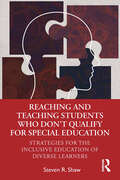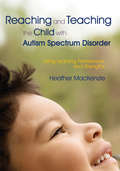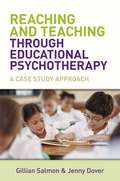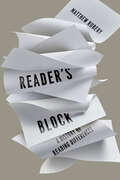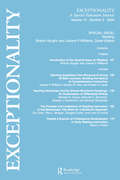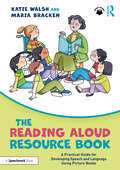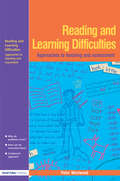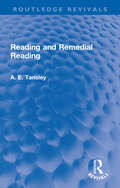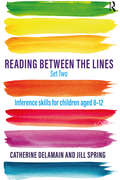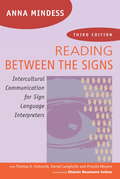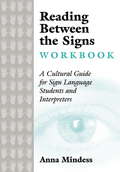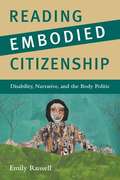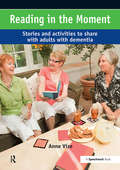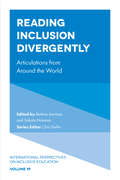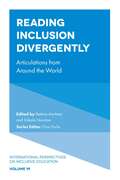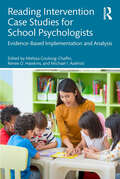- Table View
- List View
Reaching and Teaching Students Who Don’t Qualify for Special Education: Strategies for the Inclusive Education of Diverse Learners
by Steven R. ShawThis book helps readers understand, teach, and support children with persistent low academic achievement who don’t meet special education eligibility criteria, or for whom Tier 2 MTSS interventions are insufficient. Designed to be implemented in inclusive classrooms with minimal resources, comprehensive chapters cover topics from reading, writing, and math to executive functions, SEL, and mental health. This critical, ground-breaking volume provides teachers, psychologists, and counselors with an understanding of the issues children and adolescents with mild cognitive limitations and other causes of low academic achievement face, as well as detailed, evidence-based teaching practices to support their academic and social and emotional learning.
Reaching and Teaching Students Who Don’t Qualify for Special Education: Strategies for the Inclusive Education of Diverse Learners
by Steven R. ShawThis book helps readers understand, teach, and support children with persistent low academic achievement who don’t meet special education eligibility criteria, or for whom Tier 2 MTSS interventions are insufficient. Designed to be implemented in inclusive classrooms with minimal resources, comprehensive chapters cover topics from reading, writing, and math to executive functions, SEL, and mental health. This critical, ground-breaking volume provides teachers, psychologists, and counselors with an understanding of the issues children and adolescents with mild cognitive limitations and other causes of low academic achievement face, as well as detailed, evidence-based teaching practices to support their academic and social and emotional learning.
Reaching and Teaching the Child with Autism Spectrum Disorder: Using Learning Preferences and Strengths
by Heather MackenzieReaching and Teaching Children with Autism provides a positive approach to understanding and educating children on the autism spectrum. The book gives greater insight into the perspective and behavior of a child with autism and explores how the child's learning preferences, strengths and interests can be used to facilitate learning and enhance motivation. Based on well-researched theory and extensive clinical experience, the author provides a comprehensive model for developing lifelong independent learning skills in children with autism between the ages of 3 and 12 years old. The book describes the underlying principles, learning preferences and strengths typical of children with autism and offers a detailed but flexible program structure based on these concepts. Easy to follow activities and approaches are described in each chapter, along with clear examples and illustrations. This accessible and practical book is an essential resource for parents, teachers, support workers, therapists and others concerned with learning and development in children with autism.
Reaching and Teaching the Child with Autism Spectrum Disorder: Using Learning Preferences and Strengths (PDF)
by Heather MackenzieReaching and Teaching Children with Autism provides a positive approach to understanding and educating children on the autism spectrum. The book gives greater insight into the perspective and behavior of a child with autism and explores how the child's learning preferences, strengths and interests can be used to facilitate learning and enhance motivation. Based on well-researched theory and extensive clinical experience, the author provides a comprehensive model for developing lifelong independent learning skills in children with autism between the ages of 3 and 12 years old. The book describes the underlying principles, learning preferences and strengths typical of children with autism and offers a detailed but flexible program structure based on these concepts. Easy to follow activities and approaches are described in each chapter, along with clear examples and illustrations. This accessible and practical book is an essential resource for parents, teachers, support workers, therapists and others concerned with learning and development in children with autism.
Reaching and Teaching Through Educational Psychotherapy: A Case Study Approach
by Gillian Salmon Jenny DoverThis introduction to educational psychotherapy outlines the insights that will be of interest to teachers by discussing troubled children in the classroom who resist efforts to teach them. Its evidence-based approach allows teaching with confidence, and a clear understanding of the role of educational psychotherapy in the classroom. The book comprises four case studies of educational therapy work with children, chosen for their narrative interest and the variety of the children’s difficulties and backgrounds. As the stories of three boys and one girl unfold, the links between their learning difficulties and their social/emotional development become clear. Later chapters develop understanding of this way of working, with detailed accounts of how to assess suitability for educational therapy, psychoanalytic concepts underpinning the approach, and techniques and materials used in individual and classroom work.
Reader's Block: A History of Reading Differences
by Matthew RuberyWhat does the term "reading" mean? Matthew Rubery's exploration of the influence neurodivergence has on the ways individuals read asks us to consider that there may be no one definition. This alternative history of reading tells the stories of "atypical" readers and the impact had on their lives by neurological conditions affecting their ability to make sense of the printed word: from dyslexia, hyperlexia, and alexia to synesthesia, hallucinations, and dementia. Rubery's focus on neurodiversity aims to transform our understanding of the very concept of reading. Drawing on personal testimonies gathered from literature, film, life writing, social media, medical case studies, and other sources to express how cognitive differences have shaped people's experiences both on and off the page, Rubery contends that there is no single activity known as reading. Instead, there are multiple ways of reading (and, for that matter, not reading) despite the ease with which we use the term. Pushing us to rethink what it means to read, Reader's Block moves toward an understanding of reading as a spectrum that is capacious enough to accommodate the full range of activities documented in this fascinating and highly original book. Read it from cover to cover, out of sequence, or piecemeal. Read it upside down, sideways, or in a mirror. For just as there is no right way to read, there is no right way to read this book. What matters is that you are doing something with it—something that Rubery proposes should be called "reading."
Reader's Block: A History of Reading Differences
by Matthew RuberyWhat does the term "reading" mean? Matthew Rubery's exploration of the influence neurodivergence has on the ways individuals read asks us to consider that there may be no one definition. This alternative history of reading tells the stories of "atypical" readers and the impact had on their lives by neurological conditions affecting their ability to make sense of the printed word: from dyslexia, hyperlexia, and alexia to synesthesia, hallucinations, and dementia. Rubery's focus on neurodiversity aims to transform our understanding of the very concept of reading. Drawing on personal testimonies gathered from literature, film, life writing, social media, medical case studies, and other sources to express how cognitive differences have shaped people's experiences both on and off the page, Rubery contends that there is no single activity known as reading. Instead, there are multiple ways of reading (and, for that matter, not reading) despite the ease with which we use the term. Pushing us to rethink what it means to read, Reader's Block moves toward an understanding of reading as a spectrum that is capacious enough to accommodate the full range of activities documented in this fascinating and highly original book. Read it from cover to cover, out of sequence, or piecemeal. Read it upside down, sideways, or in a mirror. For just as there is no right way to read, there is no right way to read this book. What matters is that you are doing something with it—something that Rubery proposes should be called "reading."
Reading: A Special Issue of Exceptionality
by Sharon R. Vaughn Joanna P. WilliamsFirst Published in 2004. Routledge is an imprint of Taylor & Francis, an informa company.
Reading: A Special Issue of Exceptionality
by Sharon Vaughn Joanna P. WilliamsFirst Published in 2004. Routledge is an imprint of Taylor & Francis, an informa company.
The Reading Aloud Resource Book: A Practical Guide for Developing Speech and Language Using Picture Books
by Katie Walsh Maria BrackenThis practical guide is the ideal tool for the busy practitioner or speech and language therapist to provide an effective, meaningful, and contextualised approach to language development using picture books. Drawing from up-to-date, evidence-based research, each chapter shows you how to get the most out of picture books to support language development, with a focus on the range of opportunities that reading aloud can bring. The guide offers a complete package to promote speech, language, and early literacy, and to enrich language comprehension, vocabulary, phonological awareness, and oral language – all by using books to provide a context for meaningful language learning. The resource also includes advice on how to develop intervention goals and outcome measures for reading aloud, with practical suggestions covering topics from creating a reading routine and book nooks, to encouraging reluctant readers and reading aloud challenges. Language skills are essential for academic, social and communication success and this reading aloud resource will be valuable reading for early year educators, primary teachers, and speech and language therapists working with young children aged 0-7.
The Reading Aloud Resource Book: A Practical Guide for Developing Speech and Language Using Picture Books
by Katie Walsh Maria BrackenThis practical guide is the ideal tool for the busy practitioner or speech and language therapist to provide an effective, meaningful, and contextualised approach to language development using picture books. Drawing from up-to-date, evidence-based research, each chapter shows you how to get the most out of picture books to support language development, with a focus on the range of opportunities that reading aloud can bring. The guide offers a complete package to promote speech, language, and early literacy, and to enrich language comprehension, vocabulary, phonological awareness, and oral language – all by using books to provide a context for meaningful language learning. The resource also includes advice on how to develop intervention goals and outcome measures for reading aloud, with practical suggestions covering topics from creating a reading routine and book nooks, to encouraging reluctant readers and reading aloud challenges. Language skills are essential for academic, social and communication success and this reading aloud resource will be valuable reading for early year educators, primary teachers, and speech and language therapists working with young children aged 0-7.
Reading and Learning Difficulties: Approaches To Teaching And Assessment
by Peter WestwoodFirst Published in 2005. Routledge is an imprint of Taylor & Francis, an informa company.
Reading and Learning Difficulties
by Peter WestwoodFirst Published in 2005. Routledge is an imprint of Taylor & Francis, an informa company.
Reading and Remedial Reading (Routledge Revivals)
by A. E. TansleyFirst published in 1967, Reading and Remedial Reading describes the normal reading programme in the school where the author taught and the diagnosis and treatment of acute difficulties in learning to read. The work deals mainly with so-called educationally maladjusted children, many of whom showed signs of possible damage to the central nervous system, but Mr Tansley believes that the methods and techniques given are applicable to all children, irrespective of levels of intelligence, who are experiencing difficulties to learn. The results achieved are most encouraging and have been tested by numerous expert visitors from this country and abroad. This is a helpful guide to a large number of people- staffs and students in University Education Departments, educational psychologists, remedial teachers, special-school teachers, primary school teachers, and medical officers in the School Health Service.
Reading and Remedial Reading (Routledge Revivals)
by A. E. TansleyFirst published in 1967, Reading and Remedial Reading describes the normal reading programme in the school where the author taught and the diagnosis and treatment of acute difficulties in learning to read. The work deals mainly with so-called educationally maladjusted children, many of whom showed signs of possible damage to the central nervous system, but Mr Tansley believes that the methods and techniques given are applicable to all children, irrespective of levels of intelligence, who are experiencing difficulties to learn. The results achieved are most encouraging and have been tested by numerous expert visitors from this country and abroad. This is a helpful guide to a large number of people- staffs and students in University Education Departments, educational psychologists, remedial teachers, special-school teachers, primary school teachers, and medical officers in the School Health Service.
Reading Between the Lines Set Two: Inference skills for children aged 8 – 12
by Catherine Delamain Jill SpringReading Between the Lines Set Two is a sequel to the popular Reading Between the Lines. It is a resource book for teachers, teaching assistants, SENCOs and Speech and Language Therapists who need to support the development of inference skills in children aged 8–12. These unique guides offer accessible and easy-to-use material specifically targeted to improve inference, which is a crucial element in understanding spoken and written language. The book provides 370 engaging texts themed around different areas such as place and occupation, and includes short stories about everyday events, magic and adventure. Each short text is accompanied by guiding questions and is carefully graded to allow students to gradually progress from more simple texts with highlighted clues onto more challenging scenarios which will require higher level inferencing skills. Containing handy photocopiable material, this guide can be used with whole classes, small groups or individual children. It will be particularly valuable to professionals working with children who have Autism Spectrum Disorders or Speech, Language and Communication Needs, who need particular support with inference as they develop their broader social communication skills.
Reading Between the Lines Set Two: Inference skills for children aged 8 – 12
by Catherine Delamain Jill SpringReading Between the Lines Set Two is a sequel to the popular Reading Between the Lines. It is a resource book for teachers, teaching assistants, SENCOs and Speech and Language Therapists who need to support the development of inference skills in children aged 8–12. These unique guides offer accessible and easy-to-use material specifically targeted to improve inference, which is a crucial element in understanding spoken and written language. The book provides 370 engaging texts themed around different areas such as place and occupation, and includes short stories about everyday events, magic and adventure. Each short text is accompanied by guiding questions and is carefully graded to allow students to gradually progress from more simple texts with highlighted clues onto more challenging scenarios which will require higher level inferencing skills. Containing handy photocopiable material, this guide can be used with whole classes, small groups or individual children. It will be particularly valuable to professionals working with children who have Autism Spectrum Disorders or Speech, Language and Communication Needs, who need particular support with inference as they develop their broader social communication skills.
Reading Between the Signs: Intercultural Communication for Sign Language Interpreters
by Anna MindessIn Reading Between the Signs, Anna Mindess provides a perspective on a culture that is not widely understood - American Deaf culture. With the collaboration of three distinguished Deaf consultants, Mindess explores the implications of cultural differences at the intersection of the Deaf and hearing worlds. Used in sign language interpreter training programs worldwide, Reading Between the Signs is a resource for students, working interpreters and other professionals. This important new edition retains practical techniques that enable interpreters to effectively communicate their clients' intent, while its timely discussion of the interpreter's role is broadened in a cultural context. NEW TO THIS EDITION: New chapter explores the changing landscape of the interpreting field and discusses the concepts of Deafhood and Deaf heart. This examination of using Deaf interpreters pays respect to the profession, details techniques and shows the benefits of collaboration.
Reading Between the Signs Workbook: A Cultural Guide for Sign Language Students and Interpreters
by Anna MindessThis helpful workbook functions as a companion and supplement to Anna Mindess's earlier book, Reading Between the Signs: A Cultural Guide for Sign Language Interpreters, a recognized classic text for sign language interpreters and ASL students. It is arranged to correspond with the theory presented in the book and expands its focus to the relativity of politeness and the distinction between direct and indirect communication styles, both of which are important elements in comparing Deaf and mainstream cultures. Hands-on exercises allow students to better comprehend the sometimes-puzzling differences of culturally appropriate behavior. The book also helps students explore their own culture as well as the American Deaf culture in ways that reveal the differences between the two. Role play, discussion topics and critical incidents increase first-hand understanding of the relationship between the Deaf and Hearing communities.
Reading Embodied Citizenship: Disability, Narrative, And The Body Politic
by Emily RussellLiberal individualism, a foundational concept of American politics, assumes an essentially homogeneous population of independent citizens. When confronted with physical disability and the contradiction of seemingly unruly bodies, however, the public searches for a story that can make sense of the difference. The narrative that ensues makes "abnormality" an important part of the dialogue about what a genuine citizen is, though its role is concealed as an exception to the rule of individuality rather than a defining difference. Reading Embodied Citizenship brings disability to the forefront, illuminating its role in constituting what counts as U. S. citizenship. Drawing from major figures in American literature, including Mark Twain, Flannery O'Connor, Carson McCullers, and David Foster Wallace, as well as introducing texts from the emerging canon of disability studies, Emily Russell demonstrates the place of disability at the core of American ideals. The narratives prompted by the encounter between physical difference and the body politic require a new understanding of embodiment as a necessary conjunction of physical, textual, and social bodies. Russell examines literature to explore and unsettle long-held assumptions about American citizenship.
Reading in the Moment: Activities and Stories to Share with Adults with Dementia
by Anne VizeStudies have shown that reading in a melodic and rhythmic voice can produce positive changes in mood, emotion and behaviour in those with dementia. This book features: a detailed section on the background of how and what to read to those with dementia, as well as the research behind bibliotherapy.
Reading Inclusion Divergently: Articulations from Around the World (International Perspectives on Inclusive Education #19)
by Chris ForlinThis volume offers a critical orientation to inclusive education by centering the learnings that emerge from regional struggles in the world to actualize global ideals and commitments. Grounded in assumptions that challenge medicalized notions of disability and difference, the inquiries within this book register a range of theoretical frameworks. Such frames compel us to both interrogate the foundational premises within global discourses of inclusion and to inquire into the complexities wrought by entrenched systems of schooling. Collectively, they articulate the inseparability of inclusive education from historical processes that include conditions in post-colonial/post-war contexts as well as “developed” regions. The book therefore acknowledges and values the fluidity of inclusive processes that cannot be neatly pre-defined. This conscious awareness of the contingent nature of inclusive practice suggests new modes of coming to know inclusion for the authors in this book. Their chapters explore methodological practices that can re-direct inquiries to hold such complexity while retaining commitments to inclusion.
Reading Inclusion Divergently: Articulations from Around the World (International Perspectives on Inclusive Education #19)
by Chris ForlinThis volume offers a critical orientation to inclusive education by centering the learnings that emerge from regional struggles in the world to actualize global ideals and commitments. Grounded in assumptions that challenge medicalized notions of disability and difference, the inquiries within this book register a range of theoretical frameworks. Such frames compel us to both interrogate the foundational premises within global discourses of inclusion and to inquire into the complexities wrought by entrenched systems of schooling. Collectively, they articulate the inseparability of inclusive education from historical processes that include conditions in post-colonial/post-war contexts as well as “developed” regions. The book therefore acknowledges and values the fluidity of inclusive processes that cannot be neatly pre-defined. This conscious awareness of the contingent nature of inclusive practice suggests new modes of coming to know inclusion for the authors in this book. Their chapters explore methodological practices that can re-direct inquiries to hold such complexity while retaining commitments to inclusion.
Reading Intervention Case Studies for School Psychologists: Evidence-Based Implementation and Analysis
by Melissa Coolong-Chaffin Renee O. Hawkins Michael I. AxelrodReading Intervention Case Studies for School Psychologists provides vivid, real-world examples of school-based interventions targeting students’ phonological awareness, phonics, fluency, and comprehension in reading. This book offers a rich variety of applied reading interventions in school settings , spanning strategies such as incidental teaching, word boxes, peer tutoring, taped words, story mapping, and beyond. Each case includes thorough descriptions of the specific area of concern, detailed intervention protocols, data collection and analysis methods, and tips for ensuring social acceptability and treatment integrity. School psychologists, along with related professionals in special education, general education, and speech-language pathology, will come away with new insights into this comprehensive set of well-researched and frequently applied reading interventions.
Reading Intervention Case Studies for School Psychologists: Evidence-Based Implementation and Analysis
by Melissa Coolong-Chaffin Renee O. Hawkins Michael I. AxelrodReading Intervention Case Studies for School Psychologists provides vivid, real-world examples of school-based interventions targeting students’ phonological awareness, phonics, fluency, and comprehension in reading. This book offers a rich variety of applied reading interventions in school settings , spanning strategies such as incidental teaching, word boxes, peer tutoring, taped words, story mapping, and beyond. Each case includes thorough descriptions of the specific area of concern, detailed intervention protocols, data collection and analysis methods, and tips for ensuring social acceptability and treatment integrity. School psychologists, along with related professionals in special education, general education, and speech-language pathology, will come away with new insights into this comprehensive set of well-researched and frequently applied reading interventions.
